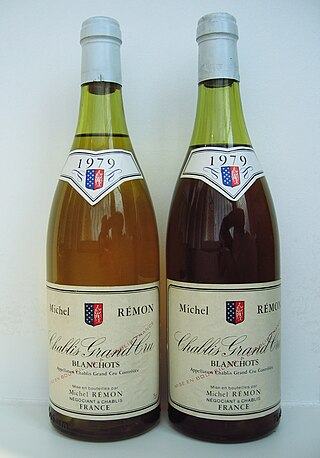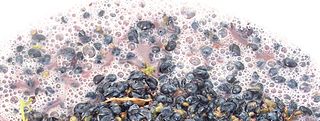
Cork is an impermeable buoyant material, the phellem layer of bark tissue that is harvested for commercial use primarily from Quercus suber, which is native to southwest Europe and northwest Africa. Cork is composed of suberin, a hydrophobic substance. Because of its impermeable, buoyant, elastic, and fire retardant properties, it is used in a variety of products, the most common of which is wine stoppers.

Cork taint is a broad term referring to an off-odor and off-flavor wine fault arising from the presence of 2,4,6-trichloroanisole (TCA), a chemical compound that represents one of the strongest off-flavors, and one "generated naturally in foods/beverages", in particular wines, that considerably reduce the quality of these products.

Bottle variation is the degree to which different bottles, nominally of the same product, can have different taste, smell, etc.
A screw cap or closure is a common type of closure for bottles, jars, and tubes.

Red wine is a type of wine made from dark-colored grape varieties. The color of the wine can range from intense violet, typical of young wines, through to brick red for mature wines and brown for older red wines. The juice from most purple grapes is greenish-white, the red color coming from anthocyan pigments present in the skin of the grape. Much of the red wine production process involves extraction of color and flavor components from the grape skin.

Bottling lines are production lines that fill a product, generally a beverage, into bottles on a large scale. Many prepared foods are also bottled, such as sauces, syrups, marinades, oils and vinegars.
A wine fault is a sensory-associated (organoleptic) characteristic of a wine that is unpleasant, and may include elements of taste, smell, or appearance, elements that may arise from a "chemical or a microbial origin", where particular sensory experiences might arise from more than one wine fault. Wine faults may result from poor winemaking practices or storage conditions that lead to wine spoilage.
Oxygen transmission rate (OTR) is the measurement of the amount of oxygen gas that passes through a substance over a given period. It is mostly carried out on non-porous materials, where the mode of transport is diffusion, but there are a growing number of applications where the transmission rate also depends on flow through apertures of some description.

Wine corks are a stopper used to seal wine bottles. They are typically made from cork, though synthetic materials can be used. Common alternative wine closures include screw caps and glass stoppers. 68 percent of all cork is produced for wine bottle stoppers.

Closure is a term used in the wine industry to refer to a stopper, the object used to seal a bottle and avoid harmful contact between the wine and oxygen.

The process of fermentation in winemaking turns grape juice into an alcoholic beverage. During fermentation, yeasts transform sugars present in the juice into ethanol and carbon dioxide. In winemaking, the temperature and speed of fermentation are important considerations as well as the levels of oxygen present in the must at the start of the fermentation. The risk of stuck fermentation and the development of several wine faults can also occur during this stage, which can last anywhere from 5 to 14 days for primary fermentation and potentially another 5 to 10 days for a secondary fermentation. Fermentation may be done in stainless steel tanks, which is common with many white wines like Riesling, in an open wooden vat, inside a wine barrel and inside the wine bottle itself as in the production of many sparkling wines.

PlumpJack Winery is a boutique winery in Oakville, California specializing in premium Cabernet Sauvignon wines. PlumpJack was the first winery in Napa Valley to use screwcaps as a wine closure on fine wines. The winery is one of several businesses operated by the PlumpJack Group. The name of the company is inspired by "the roguish spirit of Shakespeare's Sir John Falstaff, dubbed Plump Jack by Queen Elizabeth."

Screaming Eagle Winery and Vineyards is a California wine estate producing limited amounts of varietal wine; due to the small quantities produced and high prices commanded, their wines are considered cult wines. The winery is located in Oakville, California, north of the town of Napa in the Napa Valley.

The aging of wine is potentially able to improve the quality of wine. This distinguishes wine from most other consumable goods. While wine is perishable and capable of deteriorating, complex chemical reactions involving a wine's sugars, acids and phenolic compounds can alter the aroma, color, mouthfeel and taste of the wine in a way that may be more pleasing to the taster. The ability of a wine to age is influenced by many factors including grape variety, vintage, viticultural practices, wine region and winemaking style. The condition that the wine is kept in after bottling can also influence how well a wine ages and may require significant time and financial investment. The quality of an aged wine varies significantly bottle-by-bottle, depending on the conditions under which it was stored, and the condition of the bottle and cork, and thus it is said that rather than good old vintages, there are good old bottles. There is a significant mystique around the aging of wine, as its chemistry was not understood for a long time, and old wines are often sold for extraordinary prices. However, the vast majority of wine is not aged, and even wine that is aged is rarely aged for long; it is estimated that 90% of wine is meant to be consumed within a year of production, and 99% of wine within 5 years.

Storage of wine is an important consideration for wine that is being kept for long-term aging. While most wine is consumed within 24 hours of purchase, fine wines are often set aside for long-term storage. Wine is one of the few commodities that can improve in flavour and value with age, but it can also rapidly deteriorate if kept in inadequate conditions.

A screw cap is a metal, normally aluminium, cap that screws onto threads on the neck of a wine bottle, generally with a metal skirt down the neck to resemble the traditional wine capsule ("foil"). A layer of plastic, cork, rubber, or other soft material is used as wad to make a seal with the mouth of the bottle. Its use as an alternative to cork for sealing wine bottles is gaining increasing support. In markets such as Australia and New Zealand screw caps on bottles have overtaken cork to become the most common means of sealing bottles.
Pewsey Vale vineyard was founded in Eden Valley, South Australia during 1847 by Englishman, Joseph Gilbert. It is currently part of S.Smith and son. It was the first vineyard established in what is now the Eden Valley wine region and the first to plant Riesling vines in Australia. Pewsey Vale has become one of Australia’s leading producers of commercial riesling, with its signature wine being the Contours Riesling.
Grosset Wines is an Australian winery based in the Clare Valley wine region of South Australia.
Nomacorc is a producer of engineered synthetic corks for wine bottles. Nomacorc closures use co-extruded technology to manage the oxygen transfer rate (OTR) needed for wine, protecting against off-flavors in wine due to oxidation, reduction of 2,4,6-trichloroanisole (TCA) commonly known as cork taint.


















